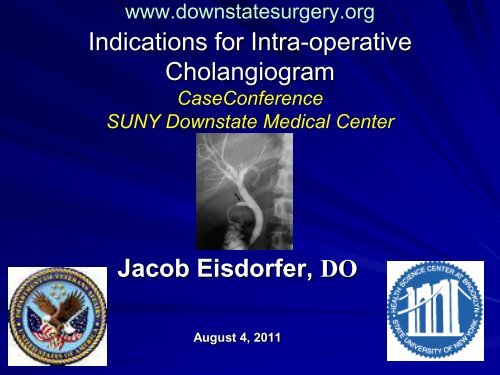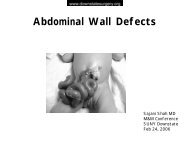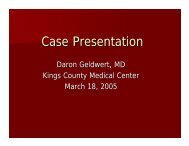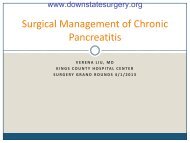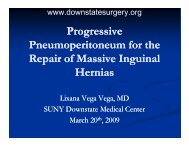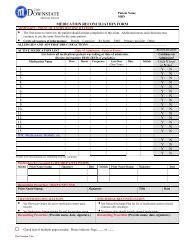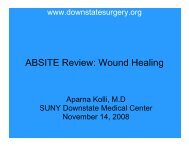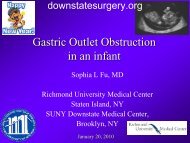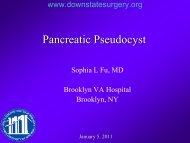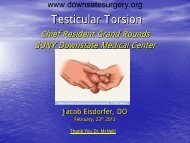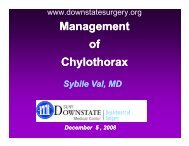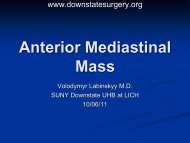Intraoperative Cholangiography - Department of Surgery at SUNY ...
Intraoperative Cholangiography - Department of Surgery at SUNY ...
Intraoperative Cholangiography - Department of Surgery at SUNY ...
You also want an ePaper? Increase the reach of your titles
YUMPU automatically turns print PDFs into web optimized ePapers that Google loves.
www.downst<strong>at</strong>esurgery.org<br />
Indic<strong>at</strong>ions for Intra-oper<strong>at</strong>ive<br />
Cholangiogram<br />
CaseConference<br />
<strong>SUNY</strong> Downst<strong>at</strong>e Medical Center<br />
Jacob Eisdorfer, DO<br />
August 4, 2011
www.downst<strong>at</strong>esurgery.org<br />
37y/o M presented to the ER<br />
– Known h/o gallstones<br />
– Constant RUQ pain X 5days<br />
– Jaundice<br />
PMHx: Denies<br />
PSHx: Denies<br />
Case
www.downst<strong>at</strong>esurgery.org<br />
Case<br />
Physical Exam:<br />
– VS: 97.7 69 17 123/80<br />
Scleral & dermal icterus<br />
Abdomen: s<strong>of</strong>t, Nondistended, (+)RUQ<br />
tenderness; mild epigastric tenderness No<br />
Murphy's sign, No rebound or Guarding<br />
Labs:<br />
– WBC: 4.8 TBili 5.9 AlkP 255 AST 184 ALT 454<br />
Amy 56 Lip 29
www.downst<strong>at</strong>esurgery.org<br />
Ultrasound
www.downst<strong>at</strong>esurgery.org<br />
Ultrasound<br />
Cholelithiasis<br />
No Pericholecystic fluid<br />
Gall Bladder Wall: 3.4mm<br />
CBD: 1.18cm.
www.downst<strong>at</strong>esurgery.org<br />
Hospital Day # 2: MRCP<br />
Common Bile Duct P<strong>at</strong>ent and <strong>of</strong> normal caliber<br />
without evidence <strong>of</strong> filling defects<br />
2 to 4 mm layering filling defects are seen in the<br />
gallbladder fundus<br />
Gallbladder without evidence <strong>of</strong> wall thickening<br />
- Labs: Tbili: 5.2, AlkP: 228
www.downst<strong>at</strong>esurgery.org<br />
Hospital Day #3<br />
Laparoscopic Cholecystectomy<br />
– JP Drain Placed because <strong>of</strong> bile spillage<br />
from fundus <strong>of</strong> GB<br />
– Evening Labs:<br />
– Tbili: 3.6, AlkP: 198<br />
– AM Labs (POD#1):<br />
– Tbili: 3.3, AlkP: 204<br />
– Discharged home
www.downst<strong>at</strong>esurgery.org<br />
POD # 3<br />
Return to ED for Evalu<strong>at</strong>ion and Drain<br />
Removal<br />
– Labs: Tbili: 2.2, AlkP: 217<br />
– Drain Removed
www.downst<strong>at</strong>esurgery.org<br />
POD #4<br />
Returned to ER with RUQ Pain<br />
– Labs: Tbili: 2.6, AlkP: 364<br />
– Arrangements made for MRCP then ERCP if<br />
MRCP is abnormal
www.downst<strong>at</strong>esurgery.org<br />
POD#6<br />
Returned to Clinic<br />
– Labs: Tbili: 2.6, AlkP: 521<br />
MRCP: CBD normal caliber measuring 4 mm.<br />
No significant intrahep<strong>at</strong>ic biliary ductal<br />
dil<strong>at</strong><strong>at</strong>ion. No choledocholithiasis.
www.downst<strong>at</strong>esurgery.org<br />
POD # 11<br />
Returned to ER for Labs<br />
– Labs: TBili: 1.3 AlkP: 262<br />
– Feels fine
www.downst<strong>at</strong>esurgery.org<br />
<strong>Intraoper<strong>at</strong>ive</strong> Cholangiogram<br />
Agenda:<br />
– An<strong>at</strong>omy<br />
– History<br />
– Routine vs. Selective use<br />
– Preoper<strong>at</strong>ive predictors <strong>of</strong><br />
Choledocholithiasis<br />
– MRCP / EUS<br />
– Algorithm<br />
– Summary
<strong>Intraoper<strong>at</strong>ive</strong> <strong>Cholangiography</strong><br />
An<strong>at</strong>omy:<br />
www.downst<strong>at</strong>esurgery.org
<strong>Intraoper<strong>at</strong>ive</strong> <strong>Cholangiography</strong><br />
An<strong>at</strong>omy:<br />
www.downst<strong>at</strong>esurgery.org
<strong>Intraoper<strong>at</strong>ive</strong> <strong>Cholangiography</strong><br />
An<strong>at</strong>omy:<br />
www.downst<strong>at</strong>esurgery.org
www.downst<strong>at</strong>esurgery.org<br />
<strong>Intraoper<strong>at</strong>ive</strong> <strong>Cholangiography</strong><br />
History<br />
– Reich in 1918<br />
First to visualize the extrahep<strong>at</strong>ic biliary tree<br />
Injected bismuth and petrol<strong>at</strong>um and defined a<br />
biliary fistula<br />
– Mirizzi in 1932<br />
First series <strong>of</strong> intraoper<strong>at</strong>ive cholangiograms<br />
Using st<strong>at</strong>ic films<br />
– Berci and colleagues in 1978<br />
Mobile C-arm image intensifier using a TV monitor<br />
MacFadyen BV. <strong>Intraoper<strong>at</strong>ive</strong> cholangiography: past, present, and future. Surg<br />
Endosc. 2006 Apr;20 Suppl 2:S436-40. Epub 2006 Mar 23. (Agusta, GA)
www.downst<strong>at</strong>esurgery.org<br />
<strong>Intraoper<strong>at</strong>ive</strong> <strong>Cholangiography</strong><br />
Arguments for Routine <strong>Intraoper<strong>at</strong>ive</strong><br />
<strong>Cholangiography</strong><br />
– Detection <strong>of</strong> Bile Stones<br />
5%<br />
– Detection <strong>of</strong> an<strong>at</strong>omical ductal abnormalities<br />
12%<br />
– CBD injury without IOC<br />
0.4-0.6%<br />
– CBD injury with IOC<br />
0.2-0.4%<br />
Flum DR, Dellinger EP, Cheadle A, Chan L, Koepsell T. <strong>Intraoper<strong>at</strong>ive</strong><br />
cholangiography and risk <strong>of</strong> common bile duct injury during cholecystectomy.<br />
JAMA. 2003 Apr 2;289(13) (Se<strong>at</strong>tle)
www.downst<strong>at</strong>esurgery.org<br />
<strong>Intraoper<strong>at</strong>ive</strong> <strong>Cholangiography</strong><br />
Arguments Against Routine <strong>Intraoper<strong>at</strong>ive</strong><br />
<strong>Cholangiography</strong><br />
– Cannot be performed in 5%-9%<br />
– Does not elimin<strong>at</strong>e CBD injury<br />
Only part <strong>of</strong> the process<br />
– Meticulous dissection & visualiz<strong>at</strong>ion more important<br />
Cuschieri, A., Dubois, F., Mouiel, J., Mouret, P., Becker, H., Buess, G., Trede, M.,<br />
Troidl, H.: The European experience with laparoscopic cholecystectomy. Am. J.<br />
Surg. 161:385, 1991<br />
Gillams, A., Cheslyn-Curtis, S., Russell, R.C.G., Lees, W.R.: Can cholangiography<br />
be safely abandoned in laparoscopic cholecystectomy? Ann. R. Coll. Surg. Engl.<br />
74:248, 1992
www.downst<strong>at</strong>esurgery.org<br />
<strong>Intraoper<strong>at</strong>ive</strong> <strong>Cholangiography</strong><br />
Arguments Against Routine <strong>Intraoper<strong>at</strong>ive</strong><br />
<strong>Cholangiography</strong> (Cont’)<br />
– Small stones th<strong>at</strong> are not suspected<br />
clinically are likely to be insignificant<br />
– False positives & False Neg<strong>at</strong>ives<br />
– MRCP<br />
– ERCP<br />
– Increased Oper<strong>at</strong>ing Time & Cost (?)<br />
Cuschieri, A., Dubois, F., Mouiel, J., Mouret, P., Becker, H., Buess, G., Trede, M., Troidl, H.:<br />
The European experience with laparoscopic cholecystectomy. Am. J. Surg. 161:385, 1991<br />
(UK)<br />
Gillams, A., Cheslyn-Curtis, S., Russell, R.C.G., Lees, W.R.: Can cholangiography be safely<br />
abandoned in laparoscopic cholecystectomy? Ann. R. Coll. Surg. Engl. 74:248, 1992 (UK)
www.downst<strong>at</strong>esurgery.org<br />
<strong>Intraoper<strong>at</strong>ive</strong> <strong>Cholangiography</strong><br />
Indic<strong>at</strong>ions for IOC:<br />
– Elev<strong>at</strong>ed preoper<strong>at</strong>ive liver enzymes<br />
– Unclear an<strong>at</strong>omy during laparoscopic<br />
dissection<br />
– Dil<strong>at</strong>ed CBD on preoper<strong>at</strong>ive imaging<br />
– Gallstone Pancre<strong>at</strong>itis without endoscopic<br />
clearance <strong>of</strong> CBD<br />
– Jaundice<br />
– Many small stones in gall bladder<br />
– Unsuccessful preoper<strong>at</strong>ive ERCP for<br />
choledocholithiasis<br />
Chari RS, Shah SA. Biliary System. In: Townsend CM Jr, Beauchamp DR, Evers BM,<br />
M<strong>at</strong>tox KL eds. Sabiston Textbook <strong>of</strong> <strong>Surgery</strong>. 18th ed. Philadelphia, PA :<br />
SAUNDERS ELSEVIER , 2008. p 1565
www.downst<strong>at</strong>esurgery.org<br />
<strong>Intraoper<strong>at</strong>ive</strong> <strong>Cholangiography</strong><br />
Predictors <strong>of</strong> CBD Stones:<br />
– Studies are all over the place<br />
– Elev<strong>at</strong>ed Early On:<br />
alanine aminotransferase (ALT)<br />
– L<strong>at</strong>er:<br />
Bilirubin, AlkP, GGT<br />
Pr<strong>at</strong> F, Meduri B, Ducot B, Chiche R, Salimbeni-Bartolini R, Pelletier G Prediction <strong>of</strong><br />
common bile duct stones by noninvasive tests Ann Surg. 1999;229(3):362. (Paris)
www.downst<strong>at</strong>esurgery.org<br />
<strong>Intraoper<strong>at</strong>ive</strong> <strong>Cholangiography</strong><br />
Meta-Analysis <strong>of</strong> 22 studies<br />
TABLE 3 -- Sensitivity and Specificity<br />
Indic<strong>at</strong>or Sensitivity 95% CI Specificity 95% CI<br />
CBDS on US 0.38 0.27-0.49 1.00 0.99-1.00<br />
Cholangitis 0.11 0.02-0.19 0.99 0.99-1.00<br />
Preop jaundice 0.36 0.26-0.45 0.97 0.95-0.99<br />
Dil<strong>at</strong>ed CBD on US 0.42 0.28-0.56 0.96 0.94-0.98<br />
Amylase 0.11 0.02-0.20 0.95 0.93-0.98<br />
Pancre<strong>at</strong>itis 0.10 0.08-0.12 0.95 0.93-0.97<br />
Jaundice 0.39 0.29-0.49 0.92 0.88-0.97<br />
Bilirubin 0.69 0.48-0.90 0.88 0.84-0.92<br />
Alk phos 0.57 0.46-0.69 0.86 0.78-0.94<br />
Cholecystitis 0.50 0.11-0.89 0.76 0.45-1.00<br />
Abboud PA, Malet PF, Berlin JA, Staroscik R, etal. Predictors <strong>of</strong> common bile duct<br />
stones prior to cholecystectomy: a meta-analysis . Gastrointest Endosc. 1996;44(4):450.<br />
(UPenn)
www.downst<strong>at</strong>esurgery.org<br />
<strong>Intraoper<strong>at</strong>ive</strong> <strong>Cholangiography</strong><br />
Retrospective - 1002 p<strong>at</strong>ients who underwent<br />
laparoscopic cholecystectomy for cholelithiasis<br />
Met indic<strong>at</strong>ion for ERCP<br />
Found to have CBD stone on ERCP<br />
Yang MH, Chen TH, Wang SE, Tsai YF, Su CH, Wu CW, Lui WY, Shyr YMBiochemical<br />
predictors for absence <strong>of</strong> common bile duct stones in p<strong>at</strong>ients undergoing laparoscopic<br />
cholecystectomy. Surg Endosc. 2008;22(7):1620. (Taiwan)
www.downst<strong>at</strong>esurgery.org<br />
Tse F, Liu L, Barkun AN, Armstrong D, Moayyedi P. EUS: a meta-analysis <strong>of</strong> test performance in<br />
suspected choledocholithiasis. Gastrointest Endosc. 2008;67(2):235. (Canada)<br />
<strong>Intraoper<strong>at</strong>ive</strong> <strong>Cholangiography</strong><br />
MRCP / EUS<br />
– MRCP<br />
– EUS<br />
Meta-analysis <strong>of</strong> 67 studies (4711 p<strong>at</strong>ients)<br />
– Pooled sensitivity <strong>of</strong> 95%<br />
– Pooled specificity <strong>of</strong> 97%<br />
Meta-Analysis <strong>of</strong> 27 studies with 2673 p<strong>at</strong>ients<br />
– sensitivity <strong>of</strong> 94 percent<br />
– specificity <strong>of</strong> 95 percent<br />
Romagnuolo J, Bardou M, Rahme E, Joseph L, Reinhold C, Barkun AN. Magnetic<br />
resonance cholangiopancre<strong>at</strong>ography: a meta-analysis <strong>of</strong> test performance in<br />
suspected biliary disease. Ann Intern Med. 2003 Oct 7;139(7):547-57(Canada)
www.downst<strong>at</strong>esurgery.org<br />
<strong>Intraoper<strong>at</strong>ive</strong> <strong>Cholangiography</strong><br />
MRCP / EUS<br />
Pooled analysis <strong>of</strong> 301 p<strong>at</strong>ients from five<br />
randomized, prospective, blinded trials.<br />
– Compared EUS with MRCP,<br />
no significant difference in:<br />
– sensitivity (93 versus 85 percent)<br />
– specificity (96 versus 93 percent)<br />
Ledro-Cano D. Suspected choledocholithiasis: endoscopic ultrasound or magnetic resonance<br />
cholangio-pancre<strong>at</strong>ography? A system<strong>at</strong>ic review. Eur J Gastroenterol Hep<strong>at</strong>ol 2007; 19:1007<br />
(Spain)
www.downst<strong>at</strong>esurgery.org<br />
<strong>Intraoper<strong>at</strong>ive</strong> <strong>Cholangiography</strong><br />
MRCP / EUS<br />
– The question <strong>of</strong> slice thickness<br />
Six studies<br />
– MRCP slice thickness ≥5 mm<br />
Sensitivity - 40%<br />
Specificity – 80%<br />
– MRCP slice thickness ≤3 mm or 3D-MRCP<br />
sequences.<br />
Sensitivity - 87%,<br />
Specificity - 90%,<br />
McMahon CJ. The rel<strong>at</strong>ive roles <strong>of</strong> magnetic resonance cholangiopancre<strong>at</strong>ography (MRCP) and<br />
endoscopic ultrasound in diagnosis <strong>of</strong> common bile duct calculi: a critically appraised topic.<br />
Abdom Imaging. 2008 Jan-Feb;33(1):6-9 (Ireland)
www.downst<strong>at</strong>esurgery.org<br />
<strong>Intraoper<strong>at</strong>ive</strong> <strong>Cholangiography</strong><br />
MRCP / EUS<br />
– MRCP is preferred to EUS<br />
Noninvasive<br />
However:<br />
– Sensitivity <strong>of</strong> MRCP may be lower for small stones (
<strong>Intraoper<strong>at</strong>ive</strong> <strong>Cholangiography</strong><br />
Algorithm<br />
www.downst<strong>at</strong>esurgery.org<br />
Fogli L, Boschi S, P<strong>at</strong>rizi P, Berta RD, Al Sahlani U, Capizzi D, Capizzi FD. Laparoscopic<br />
cholecystectomy without intraoper<strong>at</strong>ive cholangiography: audit <strong>of</strong> long-term results. J<br />
Laparoendosc Adv Surg Tech A. 2009 Apr;19(2):191-3. (Italy)
www.downst<strong>at</strong>esurgery.org<br />
<strong>Intraoper<strong>at</strong>ive</strong> <strong>Cholangiography</strong><br />
Summary<br />
– Good evidence for routine IOC<br />
– Good Evidence for selective IOC<br />
– Good Evidence for rare IOC<br />
– As less invasive diagnostic and therapeutic<br />
modalities become better the roll for oper<strong>at</strong>ive<br />
interventions become less indic<strong>at</strong>ed.
www.downst<strong>at</strong>esurgery.org<br />
<strong>Intraoper<strong>at</strong>ive</strong> <strong>Cholangiography</strong><br />
Summary<br />
– My Opinion…<br />
Routine IOC
www.downst<strong>at</strong>esurgery.org<br />
THANK YOU!
www.downst<strong>at</strong>esurgery.org<br />
References<br />
MacFadyen BV. <strong>Intraoper<strong>at</strong>ive</strong> cholangiography: past, present, and future. Surg Endosc. 2006 Apr;20 Suppl<br />
2:S436-40. Epub 2006 Mar 23.<br />
Flum DR, Dellinger EP, Cheadle A, Chan L, Koepsell T. <strong>Intraoper<strong>at</strong>ive</strong> cholangiography and risk <strong>of</strong> common bile<br />
duct injury during cholecystectomy. JAMA. 2003 Apr 2;289(13)<br />
Cuschieri, A., Dubois, F., Mouiel, J., Mouret, P., Becker, H., Buess, G., Trede, M., Troidl, H.: The European<br />
experience with laparoscopic cholecystectomy. Am. J. Surg. 161:385, 1991<br />
Gillams, A., Cheslyn-Curtis, S., Russell, R.C.G., Lees, W.R.: Can cholangiography be safely abandoned in<br />
laparoscopic cholecystectomy? Ann. R. Coll. Surg. Engl. 74:248, 1992<br />
Chari RS, Shah SA. Biliary System. In: Townsend CM Jr, Beauchamp DR, Evers BM, M<strong>at</strong>tox KL eds. Sabiston<br />
Textbook <strong>of</strong> <strong>Surgery</strong>. 18th ed. Philadelphia, PA : SAUNDERS ELSEVIER , 2008. p 1565<br />
Pr<strong>at</strong> F, Meduri B, Ducot B, Chiche R, Salimbeni-Bartolini R, Pelletier G Prediction <strong>of</strong> common bile duct stones by<br />
noninvasive tests Ann Surg. 1999;229(3):362.<br />
Abboud PA, Malet PF, Berlin JA, Staroscik R, etal. Predictors <strong>of</strong> common bile duct stones prior to<br />
cholecystectomy: a meta-analysis . Gastrointest Endosc. 1996;44(4):450.<br />
Yang MH, Chen TH, Wang SE, Tsai YF, Su CH, Wu CW, Lui WY, Shyr YMBiochemical predictors for absence <strong>of</strong><br />
common bile duct stones in p<strong>at</strong>ients undergoing laparoscopic cholecystectomy. Surg Endosc. 2008;22(7):1620.<br />
Romagnuolo J, Bardou M, Rahme E, Joseph L, Reinhold C, Barkun AN. Magnetic resonance<br />
cholangiopancre<strong>at</strong>ography: a meta-analysis <strong>of</strong> test performance in suspected biliary disease. Ann Intern Med.<br />
2003 Oct 7;139(7):547-57(Canada)<br />
Tse F, Liu L, Barkun AN, Armstrong D, Moayyedi P. EUS: a meta-analysis <strong>of</strong> test performance in suspected<br />
choledocholithiasis. Gastrointest Endosc. 2008;67(2):235.<br />
Ledro-Cano D. Suspected choledocholithiasis: endoscopic ultrasound or magnetic resonance cholangiopancre<strong>at</strong>ography?<br />
A system<strong>at</strong>ic review. Eur J Gastroenterol Hep<strong>at</strong>ol 2007; 19:1007<br />
Zidi SH, Pr<strong>at</strong> F, Le Guen O, Rondeau Y, Rocher L, Fritsch J, Choury AD, Pelletier G. Use <strong>of</strong> magnetic resonance<br />
cholangiography in the diagnosis <strong>of</strong> choledocholithiasis: prospective comparison with a reference imaging method<br />
Gut. 1999;44(1):118.<br />
Fogli L, Boschi S, P<strong>at</strong>rizi P, Berta RD, Al Sahlani U, Capizzi D, Capizzi FD. Laparoscopic cholecystectomy without<br />
intraoper<strong>at</strong>ive cholangiography: audit <strong>of</strong> long-term results. J Laparoendosc Adv Surg Tech A. 2009 Apr;19(2):191-<br />
3.


